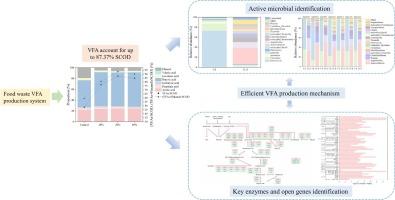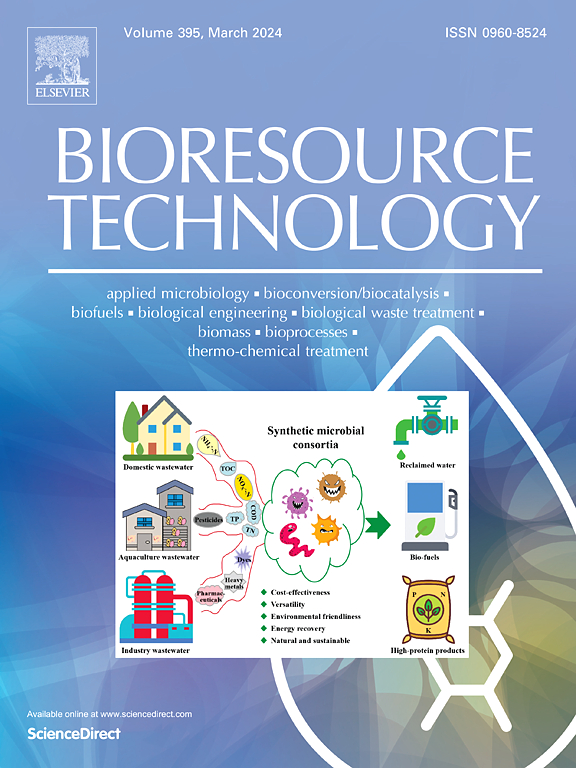Enhancement of volatile fatty acids to extremely high content in fermentation of food waste: Optimization of conditions, microbial functional genes, and mechanisms
IF 9.7
1区 环境科学与生态学
Q1 AGRICULTURAL ENGINEERING
引用次数: 0
Abstract
The engineering application of volatile fatty acids (VFA) production from food waste (FW) can significantly enhance resource utilization. Enhancing VFA production is crucial for advancing this engineering application. This study presented a economically-feasible method to achieve high VFA production from FW: Conducting fermentation at pH 9 and 37 ℃ with addition of 20 % anaerobic sludge significantly increased the conversion of FW to VFAs (80.56 g COD/L, accounting for 87.37 % of the soluble chemical oxygen demand), while also increasing the content of NH4+-N (2658.15 mg/L). Macrotranscriptomic sequencing showed that Anaerosalibacter, Amphibacillus, Wansuia, Clostridiisalibacter, unclassified Tissierellia, Massilibacterium, unclassified Bacteroidales, and Tissierellia were the key active microorganisms for VFA production. The expression abundance of functional enzymes and genes related to VFA production pathways increased during the fermentation. This study significantly advanced the practical application of VFA production from FW, offering both theoretical insights and bacterial resources.

在厨余发酵过程中提高挥发性脂肪酸的极高含量:优化条件、微生物功能基因和机制。
利用食物垃圾(FW)生产挥发性脂肪酸(VFA)的工程应用可显著提高资源利用率。提高挥发性脂肪酸的产量对于推进这一工程应用至关重要。本研究提出了一种经济可行的方法来实现餐厨垃圾中挥发性脂肪酸的高产:在 pH 值为 9、温度为 37 ℃ 的条件下进行发酵,并添加 20% 的厌氧污泥,可显著提高餐厨垃圾中挥发性脂肪酸的转化率(80.56 g COD/L,占可溶性化学需氧量的 87.37%),同时还能提高 NH4+-N 的含量(2658.15 mg/L)。宏转录组测序表明,Anaerosalibacter、Amphibacillus、Wansuia、Clostridiisalibacter、未分类 Tissierellia、Massilibacterium、未分类类杆菌属和 Tissierellia 是产生 VFA 的关键活性微生物。与 VFA 生产途径相关的功能酶和基因的表达量在发酵过程中有所增加。这项研究为从 FW 中生产 VFA 提供了理论依据和细菌资源,极大地推动了 VFA 的实际应用。
本文章由计算机程序翻译,如有差异,请以英文原文为准。
求助全文
约1分钟内获得全文
求助全文
来源期刊

Bioresource Technology
工程技术-能源与燃料
CiteScore
20.80
自引率
19.30%
发文量
2013
审稿时长
12 days
期刊介绍:
Bioresource Technology publishes original articles, review articles, case studies, and short communications covering the fundamentals, applications, and management of bioresource technology. The journal seeks to advance and disseminate knowledge across various areas related to biomass, biological waste treatment, bioenergy, biotransformations, bioresource systems analysis, and associated conversion or production technologies.
Topics include:
• Biofuels: liquid and gaseous biofuels production, modeling and economics
• Bioprocesses and bioproducts: biocatalysis and fermentations
• Biomass and feedstocks utilization: bioconversion of agro-industrial residues
• Environmental protection: biological waste treatment
• Thermochemical conversion of biomass: combustion, pyrolysis, gasification, catalysis.
 求助内容:
求助内容: 应助结果提醒方式:
应助结果提醒方式:


